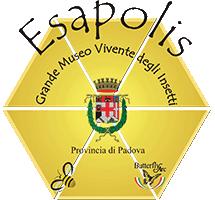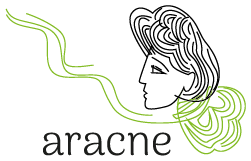Museums play a crucial role in preserving and promoting our cultural and artistic heritage. Their participation in ARACNE is essential because it brings deep insights into our traditions and history.

Esapolis Museum
Esapolis is Italy's first major insectarium, a result of a fruitful collaboration between the Province of Padua and Butterfly Arc. It came to life following the extensive
restoration of an early 20th-century building that once
housed the nation's most important sericultural station.
This historical station is still a part of the complex; it
resides in a structure located at the rear of the main
building and serves as a crucial institution for
assistance, preservation, and research under the CREA
(Council for Agricultural Research and Economics)
of the Ministry of Agriculture, Food Sovereignty and Forests. This center maintains and studies an extensive heritage of over a hundred silk moth strains. The activities of this sericulture station, historically one of the world's most significant, date back to the late 19th
century. The station's historic collections, including
instruments, tools, books, and, most notably, silk moth breeds from around the world, are now part of the Esapolis Museum.
Learn More

Instituto Murciano de Investigacion y Desarrollo Agrario y Medioambiental
The Murcian Institute for Agrarian and Environmental
Research and Development (IMIDA), as a public research organization, holds the status of an Autonomous Administrative Body. The Institute carries out its work in various sectors,
including agriculture, livestock, forestry, fishing, shellfish farming, marine aquaculture, seaweed cultivation, and any others linked to the food chain. It also focuses on the environmental, economic, and social sustainability of these sectors, as well as their impact on biodiversity, climate change, and any other aspects related to nature and the environment. The Institute's functions include conducting research,
development, and innovation (R&D&I) projects in
various sectors and environmental areas, transferring results, fostering collaborations, providing advice, facilitating training, promoting knowledge dissemination, and managing the Mar Menor Observatory. It can
establish partnerships and create joint units with
universities and research institutions. Additionally, it may participate in or form commercial entities engaged in
R&D&I activities within the specified sectors and fields.
Learn More
The Silk Museum of the Piraeus Bank Group Cultural Foundation
There are displays in both buildings. In the ground-floor
of the later building visitors can study photographs and
archival material about the fascinating, multi-faceted
personality of Dr. Konstantinos Kourtidis. Specially made
video projections recount the history of silk over time.
The main exhibition is on the first floor and presents the
pre-industrial process of breeding the silkworm and
processing the silk. Different sections focus on "unwinding" the thread of the cocoon, and the dyeing and weaving of silk fabrics; others on every-day life in Soufli in the 20th century. In the old mansion are shown unique Soufliot costumes and accessories of the local
attire, but also modern, spectacular Chinese Opera
costumes, part of the collection that was donated to the Foundation by the Embassy of the People's Republic of
China in May 2018.
Audio-visual media help visitors learn about the manifold role of silk as an element of tangible culture across time, bur also about Soufli, especially in connection with the town's historical-geographical and ecological-environmental frame of reference. The Museum organises touring exhibitions and cultural events and activities which are presented in its multi- purpose hall.
Learn More

Lapt State Silk Museum
The State Silk Museum founded by the natural scientist
Nikolai Shavrov is one of the oldest among the world’s
silk museums. The museum is located in a building,
which was specially built for the Caucasian Sericulture
Station in 1887 by Polish architect Alexander
Shimkevich. The building has a status of a cultural
heritage monument at present. The museum displays
quite a versatile and multinational exposition. The
collection features objects from 63 countries. Unlike
other silk museums (mostly displaying only silk
collections) the showing offers everything about silk and
sericulture: a unique collection of cocoons (5.000
cocoons of different origins and variations), silkworm
biology, special containers for silkworms and eggs
(approximately 200 containers), a collection of textile
artisanally produced in the Caucasus (19th century), a
collection of laces produced in Germany (approximately
400 patterns), a collection connected with a mulberry
tree and etc. There is a unique library in the museum,
keeping rare books dating back to the 18th-19th
centuries, these books about natural sciences are in
Russian, English, German, French, Italian, Rumanian,
Hungarian, Chinese, Japanese, Persian, Arabian
languages.
Learn More

